A shifting commercial landscape

"Deliver Assist" Pilot from Renault Trucks Urban Logistics; Source: Greater Paris Metropolis
The city logistics sector is evolving rapidly, especially in Europe’s major cities. To take the example of the Greater Paris Metropolis and Paris, with over 300,000 deliveries and pick-ups to stores and offices and over 100,000 deliveries related to e-commerce every day, this urban area is facing significant challenges when it comes to urban logistics. In the past years, the increase in delivery traffic has put a strain on the city’s infrastructure, worsening issues like traffic congestion, air pollution, and noise.
This phenomenon is common to other cities around the world, as the rise of online shopping and changing consumer habits have led to a massive increase in the number of packages being transported around cities. This overflow has brought more delivery services into the mix, but it’s also created inefficiencies as companies overlap and compete.
In city centres, this problem is intensified by narrow streets, pedestrian areas, and limited parking spaces. The rise in delivery volumes has brought about several environmental concerns, particularly in densely populated urban cores. More deliveries mean higher emissions and increased noise pollution. Traditional delivery vehicles play a major role in a city’s carbon footprint, making it harder for urban areas to achieve sustainability goals.
Traffic congestion and road safety have also worsened as more delivery vehicles hit the streets. Narrow roads, especially in older parts of cities, make it difficult for large trucks to navigate, causing delays and increasing the risk of accidents. The higher traffic levels also pose safety risks, especially in areas with heavy pedestrian activity. Urban space is limited and highly valuable, which complicates the integration of logistics operations. Large warehouses are often impractical in city centers, requiring creative solutions to ensure fast deliveries without disrupting everyday life.
This disruption is clear in the growing conflicts between delivery services and local communities. As delivery vehicles occupy more public spaces, problems such as noise, litter, and blocked sidewalks have become increasingly common. The constant movement of trucks and other delivery vehicles, along with the loading and unloading of goods in residential areas, can disturb daily life. Therefore, it’s essential to find solutions that ensure efficient deliveries while also addressing the needs of local residents.
Innovative Solutions for Last-Mile Logistics

Cycle-cargo delivery in a pedestrianised area of Paris; Source: Greater Paris Metropolis
One key part of urban logistics is "last-mile logistics," which is the final stretch of a delivery from a warehouse or distribution center to the customer. This has become more important as the demand for fast, reliable deliveries has skyrocketed. Cities need new strategies to minimize the negative impacts of urban logistics. Here are five ways cities and companies can improve the current system:
Logistics Spatial Planning:
Cities should plan for logistics infrastructure like warehouses and delivery hubs in optimal locations to cut travel distances and delivery times. Innovations like vertical warehouses and logistics hotels can help operate within tight spaces.
Vehicle specialization:
Instead of using the same vehicles for long and short distances, cargo bikes offer a cleaner, faster alternative for urban deliveries, especially in areas where vans struggle such as pedestrianised areas or protected heritage districts.
Curbside Management:
Designating loading zones for delivery vehicles can reduce traffic disruptions and illegal parking, streamlining deliveries.
Embracing New Technologies:
Tools like data analytics, real-time tracking, and AI route optimization can help companies manage deliveries more efficiently and provide cities with data for better planning.
Low-Emission Zones (LEZs):
Restricting high-emission vehicles in certain areas pushes companies to use cleaner vehicles, helping reduce pollution and traffic.
Off-Peak Hour Deliveries:
Encouraging companies to deliver outside of rush hours can ease congestion, though this requires balancing noise concerns and fair worker compensation. For example, Renault Trucks Urban Logistics is currently testing a fleet semi-automated quiet electric vehicles for night deliveries
Best practices
Urban authorities are already developing innovative solutions to address urban logistics in their cities and city centres. In Italy, the city of Vicenza, has developed VeLoce, a public company to deliver goods in the limited traffic zone. The Eco-Logistic Centre only uses eco-friendly trucks, and advanced information technology for optimal management of the various stages of the shipments.
Barcelona, a city that was suffering from the logistical demands linked to the increase of food delivery and the negative impacts of dark kitchens and dark stores, has introduced a new plan to regulate delivery activities. During the first and second semesters of 2021, the number of openings had increased radically with the arrival of main global players (Getir and Gorillas) that added to the existing offer of providers (Glovo, Uber Eats, Deliveroo).
The plan sets specific guidelines based on the type and scale of each delivery operation, aiming to minimize their effects on the city. It also introduces a new delivery permit that requires businesses involved in deliveries to provide designated spaces inside their premises for riders and their bicycles during pick-ups.

A dark store in Barcelona Source : 300.000 Km/s

Impacts of dark stores on the public space Source : 300.000 Km/s
In the Greater Paris Metropolis, in order to contribute to the management of a highly dense contiguous urban zone with a population of 7 million, actors in the logistics sector came together to forge the Metropolitan Logistics Pact. With negotiations presided by the Mayor of Le Raincy, Jean-Michel Genestier, the first pact was formalised in 2018 and the 82 signatories included
trade federations, shipping authorities, the distribution sector, municipalities within the Metropolis, and consular chambers.

Signatories of the Metropolitan Logistics Pact; Source : Greater Paris Metropolis
In 2021, the pact was revisited, this time with a more operational roadmap:
Accelerate the carbon free transition of freight vehicle fleets
Deploy innovative delivery practices in the region, particularly in terms of last-mile logistics
Develop the transport of goods by waterway transport
Relocate logistics sites in the densely populated area of the Greater Paris Metropolis Better use of digital data
The example of the Greater Paris Metropolis Pact provides a way forward in logistics policy. The future of last-mile logistics will depend on continued collaboration between the public and private sectors, embracing new technologies, and implementing forward-thinking policies. By fostering a sustainable urban logistics system, cities can ensure that they meet consumer demands without compromising the environment or the quality of urban life.

